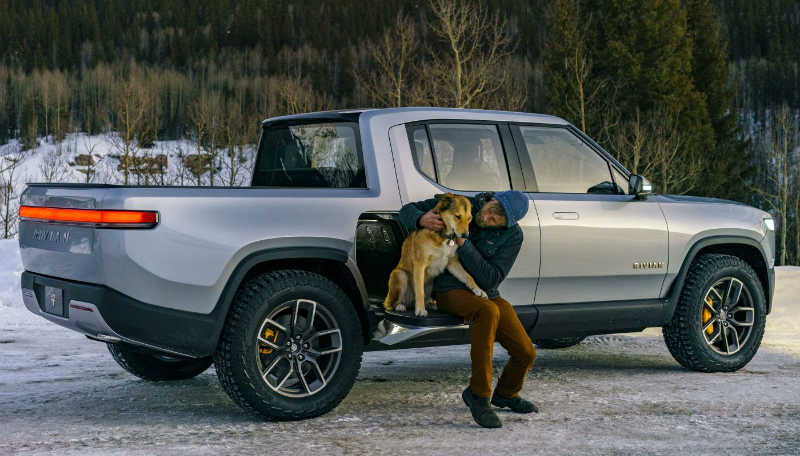When Capitalists Go Marching and Activists Go Shopping To Save The Planet
When the Federal Reserve Bank of San Francisco met recently, the keepers of Capitalism examined how to set economic policy in the age of climate change. On the one hand, this news is frightening because it means the most serious economic minds and pro-market leaders in America recognize that the forces of Mother Nature may imperil our financial future. On the other hand, this news is heartening because it signals that those charged with stewarding our economy are embracing the subject with intellectual honesty and rigor.
Further good news is that our market-based economy is innovating at an almost miraculous rate to create climate change solutions that improve our well-being and reduce our impact on the planet.
Just look at companies like Blueland and Truman’s whose beautiful, non-toxic cleaning products use sturdy reusable bottles to eliminate grime and single-use plastic waste.
(Above: Truman’s Cleaners)
Or take Rothy’s footwear that merges recycled textiles with 3-D printing to make stylish flats and sneakers that women adore. And Allbirds, purveyor of the world’s most comfortable footwear precisely because it’s made using natural materials like wool. Allbirds is so determined to sever our feet’s dependence on fossil fuel-based plastic for support, they’ve invented insoles made of naturally renewable sugarcane!
(Above: Rothy’s footwear)
Look inside an Amazon or Wal-Mart warehouse to see hydrogen fuel cells powering thousands of forklifts as the clean economy establishes tentacles in the most unsuspecting places. Hydrogen is finally having its day thanks to decades-long perseverance of companies like Plug Power and the farsighted investors behind them like Generate Capital.
Look at how TerraCycle, the world’s most innovative recycling company, now partners with Unilever, Proctor & Gamble, and Danone (and the rest of the CPG giants) in building a global reusability infrastructure to eliminate the concept of consumer packaging waste altogether. It’s called Loop, and already today, you can get Dove Shampoo and Haagen Dazs Ice Cream in stunning reusable containers.
(Above: Haagen Dazs at Loop)
Or take companies like Ecovative that are pioneering building materials that we grow. Grow! How mind-bending, how amazing. Grown materials don’t require smelters. They don’t have to be heated up to harden and take form.
We are at the dawn of a clean economy. When fully scaled up, this economy will be resilient to climate change shocks and impacts. It will move us into a new era of well-being. It will align our economic progress with Mother Nature’s capabilities to sustain it.
We can almost see that day coming into focus when every car on the dealer lot – be it an SUV, pickup truck, minivan, hatchback, or sedan – will come in thrilling styles, a panoply of colors, feature sets that delight our senses, and power-transmissions that make them all eco-friendly rockstars. They will be electric- or hydrogen-powered wonders of efficiency. Terms like “going green” and “sustainable living” will disappear from our lexicon because why bother with them in a future where the default choice is always green?
(Above: Rivian Electric Pickup Truck)
Millions of entrepreneurs, inventors, investors, sustainability professionals, and factory workers are engaged in building this future today. Bloomberg reported just last month that the U.S. “green economy” now stands at $1.3 Trillion and employs nearly 4% of the workforce!
The tragedy, however, is that as exciting and deeply moving as these displays of human ingenuity are, they are not happening nearly fast enough. Not even close. The heart-wrenching scientific reality is that we are on a collision course with disruptive climate change impacts.
In 2018, the world’s leading climate scientists said we have until roughly 2030 to cut global carbon emissions by 50% or surpass an ecological tipping point from where this is no coming back. They said we’re on the clock.
In 2016, the American Meteorological Society told us that “we’re experiencing new weather because we’ve made a new climate.” That news is heartbreaking because it means the weather of our childhood is gone forever. What lies ahead is inconceivable unless we accelerate our transformation to a clean energy economy with all speed.
What are good Capitalists to do?
As alarming as our climate situation is, I am hopeful that we will rise to the occasion and solve it. But I’ve reluctantly realized that our market-driven economy, if left to its timetable for invention and inventiveness, will fail us.
So how do we pick up the pace? How do we move into a future where sustainable choices are the default setting for the entire economy? Where nearly every single action of every company aligns with a clean economy?
We must widen our scope of activity. We must overcome our biases and recognize that tactics we might otherwise dismiss or deplore are both vital and compatible with the long-term health of our Capitalist economic system.
The 3 Keys Actions To Accelerate A Clean Economy
So, if we are serious about advancing the triple-bottom-line, if we are going to build companies and an entire economy that values People, Profit, and Planet, then the time has come to embrace Products, Policies, and Protests.
Here’s how:
1) Products: Shop Sustainably
All that incredible sustainability innovation I mentioned, we keep doing it. We’re going to need all of it. We need new ideas, more innovation, and, above all, more scale. And we use the power of our wallets to shop sustainably. That applies whether as individual consumers or as corporate procurement departments.
2) Policies: Press Our Politicians
It’s time to get political. Not just on election day. But regularly, consistently. Let’s say once a week. Make it Tuesdays. We need to develop the practice of contacting our elected leaders – from the local to the national level – and telling them that we want action on climate change now.
Doing this one day a week doesn’t seem like a heavy lift. That’s why we have Meatless Mondays. If we can go one day a week without eating meat for the greater good, then surely we can set aside 15 minutes every Tuesday to call a few of our elected representatives. Here’s an idea: since solving climate change requires tenacity, let’s call it Tenacious Tuesday.
Whether it’s tax incentives for electric cars, mandates for renewable energy, smarter building codes that require energy-efficient construction, or the Green New Deal, our politicians need to understand that our vote depends on their action.
Common Cause (one of America’s oldest, non-partisan nonprofits for advancing democratic participation) will show you the phone numbers of your elected representatives. Visit the site, enter your home address to view your tailored list.
3) Protests: Take It To The Streets
As good Capitalists, the time has come to join the march. We must take it to the streets and participate in demonstrations. Not because it’s the moral thing to do. Not because we just can’t let the kids stand out there by themselves anymore. We must join climate protests for two reasons:
A. The 3.5% Rule
There is a theory of change known as “the 3.5% rule.” developed by Professor Erica Chenoweth at Harvard University. It states that when 3.5% of a nation’s citizenry are regularly in the streets engaging in non-violent civil disobedience and protest, rapid transformational change is nearly inevitable. In America, that’s about 11 million of us showing up to demand the legislation necessary to accelerate the clean economy.
Climate activists are well-versed in this theory. This past September, reportedly, over 7 million people around the world mobilized in climate marches and strikes. As it happens, New Zealand was the only country where over 3.5% of the population participated. Last week, the New Zealand national government passed legislation committing the country to net-zero emissions by 2050. Coincidence? I doubt it, but if so, we need more just like it to secure our economic future.
B. We’ve Done It Successfully Before
Non-violent, civil disobedience and protest is as American as apple pie. We can trace it back to Thoreau in the 19th Century, and it was as much a part of the 20th Century experience as the rise of the automobile. Civil rights and universal suffrage victories were won by citizens in the streets of American cities to ensure these rights were codified into law in the halls of Congress.
Acts of civil disobedience and protest are patriotic. When our future is imperiled, and the laws are no longer commensurate with the threats Americans face, we can call on our heritage to stand up and do something about it. That time is here.
So it’s into the fray we must go. For many, that may mean making strange bedfellows. Capitalists must learn to greet activists and participate in protests. Activists must learn to activate their wallets to shop for sustainable products. And we all must meet in the middle as citizens to prod our politicians and make them earn our vote.
Many of the ideas expressed in this post are also discussed in The Last Environmentalist podcast episode about how we can all play a role in accelerating the clean economy.
Special Thanks To: This post is sponsored by Lazy Environmentalist, your go-to resource for stylish and well-designed products that elevate your sustainable lifestyle and minimize your impact. Lazy Environmentalist introduces you to cutting-edge sustainable brands and visionary designers who believe style and sustainability can go hand-in-hand.




